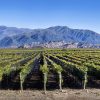Consumers would agree that Argentina is a country of reds. However, white wines are on the rise. There are three categories within the white world that already offer profiles with an indigenous flavour. Torrontés for example offers a series of variants: the classic, rich in alcohol and floral notes; the new, citrusy ones, high in freshness, and the combination between those two types.
This also happens in White Blend and Chardonnay, who have their own horizons. But let´s start at the beginning…
The Torrontés of today and tomorrow
The road of Torrontés follows the general process of wine in Argentina: while cooler regions are explored, both in the highs of the north and on the Piedmont of Cuyo, wine migrates in style. The reason can be found in the mature profiles that the variety allows.
In areas of daytime heat, such as Cafayate (Salta), it matures quickly in aromatic terms, shrinking the space between a citrus and floral profile. So, in this region, orange blossoms dominate and the palate is rich in alcohol. In colder areas, such as Paraje Altamira, in the Uco Valley (Mendoza), or Cachi and Molinos (Salta) in the North it is the opposite with slower maturity and the harvest window for each profile is enlarged. Thus, Torrontés emerges with aromas of tangerine, grapefruit and orange, with floral touches, but with a mouth rich in freshness.
Examples in each case are: for the classic Cafayate style, Laborum Finca El Recreo 2018, Anko Flor de Cardón 2018, Gran Linaje 2017 (with a touch of oak), Collovati 2018 and San Pedro de Yacochuya 2018; For the second, Susana Balbo Signature 2018 and Piedra Negra 2018, for Valle de Uco, and Adentro 2018 and Colomé 2019, for Cachi and Molinos. In the middle, for example, the rarity of El Esteco Old Vines 2018.
White Blend on the rise
White blends can also be found on the same exploratory mission. The category even uses the English name, White Blend, as a nod to differentiating style. Language apart, the fact that wineries are making more daring white blends is interesting: the exploration of tastes by combining grapes and regions.
Again Torrontés emerges as a variety capable of giving structure to new blends, and is the most planted white with 8,188 hectares (20,233 acres) in 2018, while completing the offer of Chardonnay and Sauvignon Blanc with Viognier, Semillón, Riesling and Tocai. Although these other varieties have fewer hectares.
There are even cases in which Torrontés is not present. The rest of the varieties are those that mark the course, with some Bordeaux style cases. What ends up happening is that the white´s taste profile offers complexity, good body and freshness. This last characteristic is contributed to high altitude zones, from Los Chacayes to San Pablo and Gualtallary, in the Uco Valley.
Good examples of this White Blend are: Chakana White Blend 2018 and Susana Balbo White Blend 2018, among those who have Torrontés; Proyects Hermanas 2017, Luigi Bosca Blend del Alma 2018, Nieto Senetiner White Blend 2018 and Bianchi White Blend. For Bordeaux blends, Les Foux 2018.
High altitude Chardonnay
Tupungato, Uco Valley, boasts 1,193 hectares (2,948 acres) of Chardonnay. It amounts to 59% of the surface of the valley. As a cold region within Mendoza, latitude is the main variant. Particularly when ascending to Gualtallary, where temperatures as cold as Burgundy are experienced from 1,450 meters above sea level, but in full sun and with high solar radiation.
That equation of extreme cold and sun gives a particular profile to a variety. In short, it achieves full maturity without losing freshness, so it offers fruity aromas and a rich palate with high acidity. It is rare in the world.
Examples include, Adrianna Vineyard White Stone 2017, Fósil 2017, BenMarco Sin Limites Gualtallary 2018 and Otra Piel Gualta Suelo 2016.
So then, in terms of white wines, Argentina could soon become recognised as a country of whites and reds.




Porque no hacen algo sencillo y ponen los vinos que tienen , en vez de tantas cosas que no son del tema